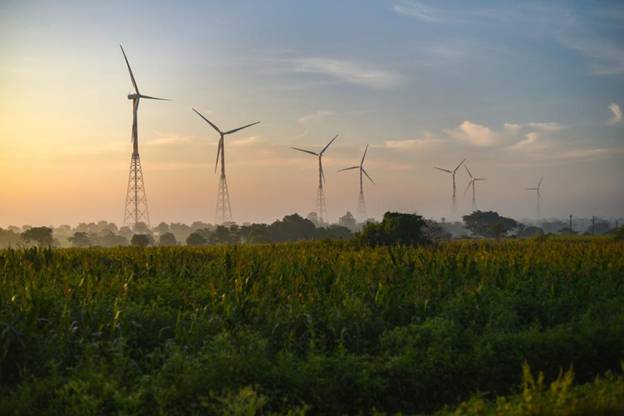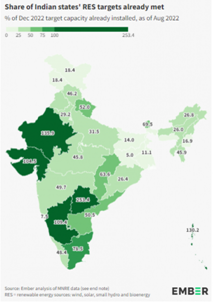INDIA’S RENEWABLE ENERGY RACE

Copyright infringement not intended
Context: India is unlikely to achieve its target of adding 175 gigawatts renewable power generation capacity by December 2022 at its current pace, a new report has claimed. The shortfall will mainly be due to four large states.
Details:
- The report is by Ember, a global energy think tank.
- Although India has set up 116 GW of RE capacity till date, it is still only 66 per cent of its 2022 target, adding a measly 6 per cent this year, or 10 GW.
- China, in comparison, has added 17 GW of solar alone in the first three months of this year and is aiming for total of 108 GW addition by end of this year, according to China’s National Energy Administration.
- Much of the shortfall is in just four states — Maharashtra, Uttar Pradesh, Andhra Pradesh and Madhya Pradesh. Cumulatively, these states have grown only 1-3 per cent in renewable energy addition this year.

- In fact, MP and UP are so far behind, that it will take them 55 and 80 more years respectively to achieve the 2022 targets at the present rate, the Ember report said.
- Four states and one Union Territory are at the forefront of RE capacity additions and have already surpassed their targets for 2022 — months ahead of time.
- Rajasthan, which has the highest installed renewable energy capacity (19.5 GW) among states, had completed its 14 GW target for 2022 in December 2021.
- The other four places that have achieved their targets till date are Karnataka, Telangana, Gujarat and Andaman & Nicobar Islands.
- Over 99 per cent of the growth this year has been led by solar and wind energy. Together, they account for 87 per cent of India’s overall current RE capacity, an analysis by the Centre for Science and Environment of MNRE’s latest data showed.
- Although solar and wind are set to become the backbone of India’s future of energy, much remains to be done to boost both sectors if we are to achieve our targets, the Ember report said.
- “Even looking at the 2030 target of 450 GW, we will need to install new capacity at 3.7 GW per month to reach that.” The highest India has done till date was 3.5 GW in March of this year, averaging at 0.9 GW addition per month since April 2019.

- New solar installations have slowed as the government introduced basic customs duty on the import of solar modules and cells. Currently, about 70 per cent of India's solar capacity comes from imported solar cells, which are locally assembled into panels and then used for grid or rooftop installations.
- The new duty may encourage domestic manufacturing in the long run, but it has significantly increased the cost pressureon under-implementation solar projects for now, the report also said.
- Wind, on the other hand, has seen a plateauing in new additions over the years. Wind accounted for only 10 per cent of newly added renewable capacity this year, down from 12 per cent during the same period last year.
- Three years ago, hydroelectric was also included in the renewable energy targets, as initially they were considered problematic in the Indian context due to various environmental and social concerns. This will certainly help India achieve the target as globally, hydel power is already considered a renewable source of energy.
- India will also benefit if it took advantage of its locally available resources and strengths. India, being an agrarian economy, produces about 500 million tonnes of biomass each year.
- Surplus biomass availability was 120-150 million tonnes per year from agricultural and forestry residues, corresponding to a potential for 18 GW in power generation capacity, studies sponsored by MNRE estimated.
- In addition to this, there is also the potential of bagasse (waste from sugar processing) cogeneration, estimated at around 8 GW on full utilisation by the 550 odd sugar mills in the country.




1.png)
